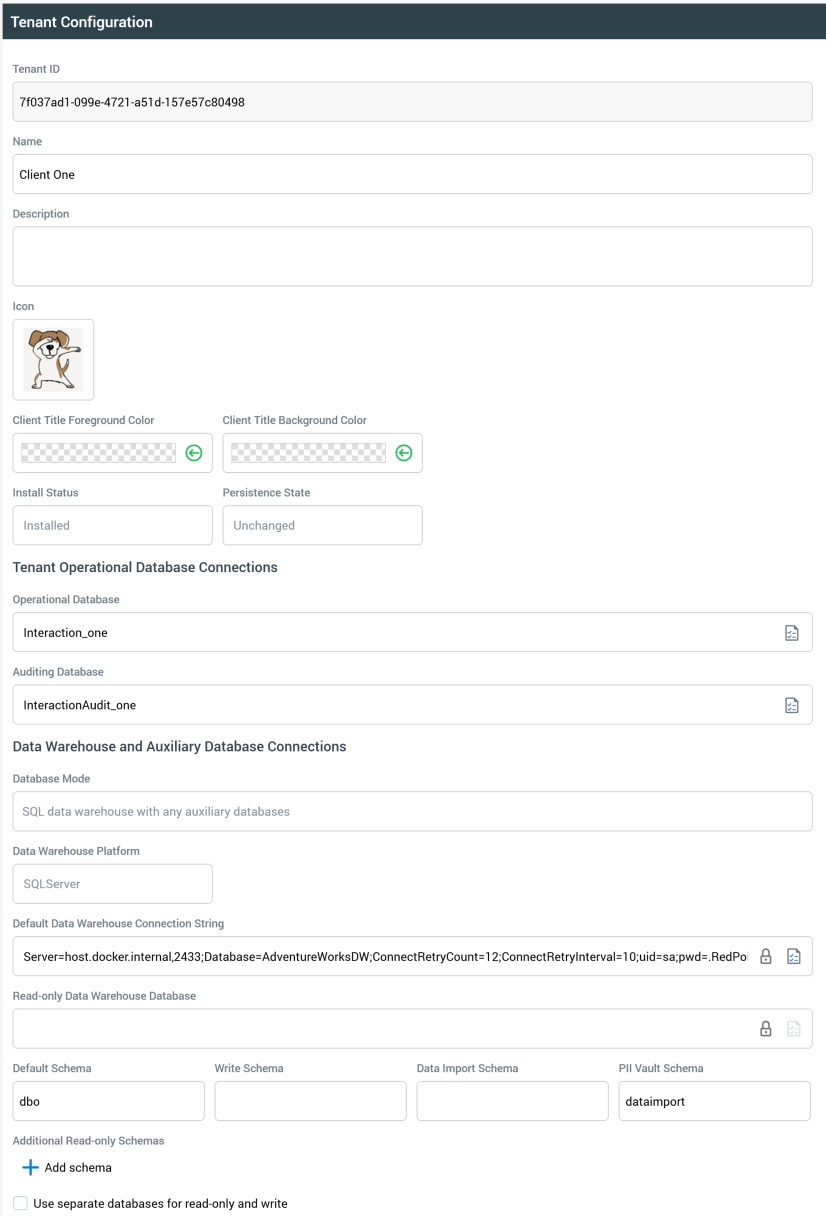Configuring the tenant
The Tenant Configuration interface is used to set properties relating to the current RPI tenant. It contains the following:

Tenant ID: read-only; a GUID property that is used to uniquely identify the current RPI tenant.
Name: this mandatory property must be unique within the current RPI installation. It accepts a maximum of 100 characters.
Description: optional, and a maximum of 1000 characters.
Icon: a default icon is provided. You can select the accompanying Change button to display a Windows file system dialog, in which you can select an image to serve as the tenant’s new icon.
Client colors: it is possible to customize the colors used to display the tenant’s name at the top of the RPI client application. Foreground and Background colors can be defined. You can set colors using the Choose Color dialog. Selecting OK changes the color; selecting Cancel removes the dialog from display without changing the color. The Revert button provided allows you to revert the client colors back to their defaults.
Install Status: one of:
Not Installed
Installed
Persistence State: one of:
Unchanged
Added
Edited
Deleted
Tenant operational database connections section
This section allow you to configure connection strings for the current RPI tenant’s operational databases. It contains the following:
Operational Database
Test button
Auditing Database
Test button
Data Warehouse and Auxiliary Database Connections section
Database Mode: read-only; one of:
SQL data warehouse with any auxiliary databases
NoSQL databases only
NoSQL databases with SQL auxiliary databases
Data Warehouse Platform: read-only
Data Warehouse Connection String
Encrypt button
Test button
Read-only Data Warehouse Database
Encrypt button
Test button
Data Warehouse Platform: read-only
Default Schema: this mandatory property allows you to specify a default schema for the data warehouse.
Write Schema: this optional property allows you to specify a separate, write, schema within which offer history and other RPI tables will be created.
Data Import Schema: this optional property allows you to specify a schema in which data import tables will be created. If not set, data import tables will be created within the write schema; if that schema is not configured, data import tables will be created within the default schema.
PII Vault Schema: when this property is set, at the Catalog configuration interface, any columns within tables in the data warehouse schema matching the supplied property value will display the Is PII Column property as checked and read-only.
Note that this will only be evident only after the catalog has been re-synchronized.
Additional Read-only Schemas: you can optionally specify one or more other data warehouse schemas to be used by RPI. Provision of a unique name for each schema is mandatory. You can add a new schema using the button provided, and remove a schema using the Remove option, available at the inline Actions menu.
Use separate databases for readonly and write: this checkbox is unchecked by default. It allows you to specify that RPI should use separate databases: a read-only data warehouse and a writeable offer history database. When checked, the following mandatory properties are displayed:
Readonly Database Name
Write Database Name
Manage Auxiliary Databases: you can optionally define one or more auxiliary databases to augment the data warehouse, and to serve as an additional source of segmentation data. Selecting this button displays the Manage Auxiliary Databases overlay.
In this section:
